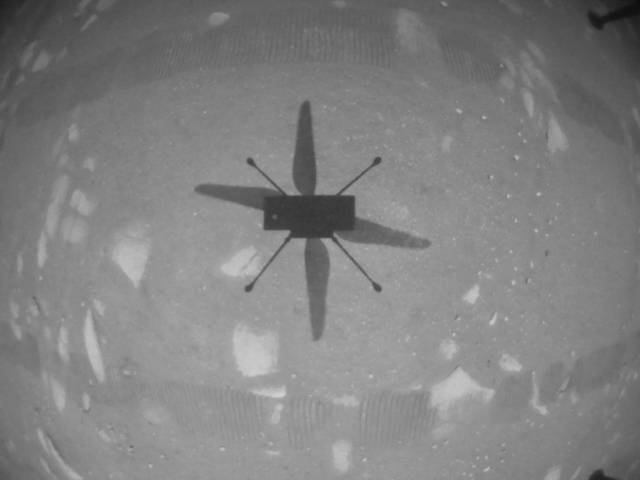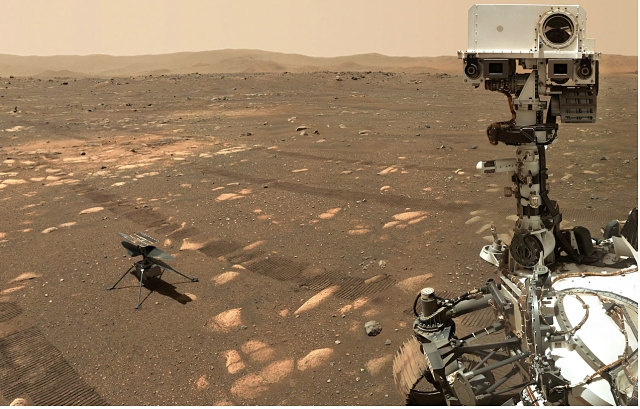 NASA’s Ingenuity Mars Helicopter captured this image of its shadow as it hovered over the Martian surface on April 19, 2021, during the first instance of powered, controlled flight on another planet. It used its navigation camera, which autonomously tracks the ground during flight. (Photo courtesy of NASA/JPL-Caltech)
NASA’s Ingenuity Mars Helicopter captured this image of its shadow as it hovered over the Martian surface on April 19, 2021, during the first instance of powered, controlled flight on another planet. It used its navigation camera, which autonomously tracks the ground during flight. (Photo courtesy of NASA/JPL-Caltech)
National Geographic
Ingenuity has lifted off the Martian surface and launched a new era of planetary exploration
A small helicopter opened a new chapter of space exploration this morning when it lifted off the surface of Mars, marking humankind’s first powered flight on another planet. The 19-inch-tall chopper called Ingenuity kicked up a little rusty red dust as it lifted about 10 feet off the ground, hovered in place, turned slightly, and slowly touched back down. The flight lasted only about 40 seconds, but it represents one of history’s most audacious engineering feats.
“A lot of people thought it was not possible to fly at Mars,” says MiMi Aung, the project manager of Ingenuity at NASA’s Jet Propulsion Laboratory (JPL). “There is so little air.”
In this video captured by NASA’s Perseverance rover, the agency’s Ingenuity Mars Helicopter took the first powered, controlled flight on another planet on April 19, 2021. (NASA Jet Propulsion Laboratory)
The wispy atmosphere at Mars’s surface is equivalent to an altitude of about 100,000 feet on Earth—much higher than even the most capable helicopters can fly. The highest helicopter flight in history occurred in 1972, when French aviator Jean Boulet flew to 40,820 feet at an airbase northwest of Marseille.
The Martian helicopter experienced a setback on April 9, when the craft’s onboard computer shut down early during a test to spin the two rotors at high speed. After reviewing the data, the team at JPL adjusted the command sequence that is sent to the spacecraft to start the rotors, allowing them to complete the high-speed spin test on April 16. And at 3:34 a.m. ET on April 19—in the midafternoon local time on Mars—the helicopter successfully completed its first flight.
In the future, similar flying machines could scout new areas for rovers and astronauts, collect samples from hard-to-reach places, and traverse dozens of miles over the span of days to provide a new perspective of the Martian landscape.
Only four pounds on Earth, which is 1.5 pounds on Mars, Ingenuity has been operating on its own since April 3, when the car-size Perseverance rover deposited it in a flat area clear of debris. A small solar panel tuned for the relatively low levels of sunlight charges the helicopter’s batteries during the day, and electric heaters keep the vehicle warm during nights that can plunge to -130°F.

NASA’s Perseverance rover took a selfie on Mars with the Ingenuity helicopter on April 6. Perseverance then drove off to an overlook about 200 feet away to watch Ingenuity’s flight attempt. (PHOTOGRAPH BY NASA/JPL-CALTECH/MSSS)
To achieve its short foray into the Martian atmosphere, the little rotorcraft relied on a tiny processor like those in cellphones, autonomous navigation technologies from self-driving cars, eight lithium-ion batteries, and lightweight composite materials. Its two carbon-fiber rotors, which span four feet from tip to tip, had to spin up to about 2,500 rotations per minute—roughly five times the speed of a normal helicopter rotor—to lift off the ground.
Now that Ingenuity has taken its first flight, the team can plan a second, which will likely perform the same hovering maneuver but a bit higher and for a bit longer. They are about halfway through a 31-day window to test the helicopter, using Perseverance as a communication relay to Earth before the rover drives off to begin its search for past life on Mars. Up to five flights are planned, building up to a trip down a 50-foot-long flight zone and back.
“It boggles your mind,” says Thomas Zurbuchen, NASA’s associate administrator for science, “flying for the first time in history a helicopter on Mars.”
“Don’t tell me anymore it’s not possible”
—
Join the conversation on Twitter and Facebook.

























